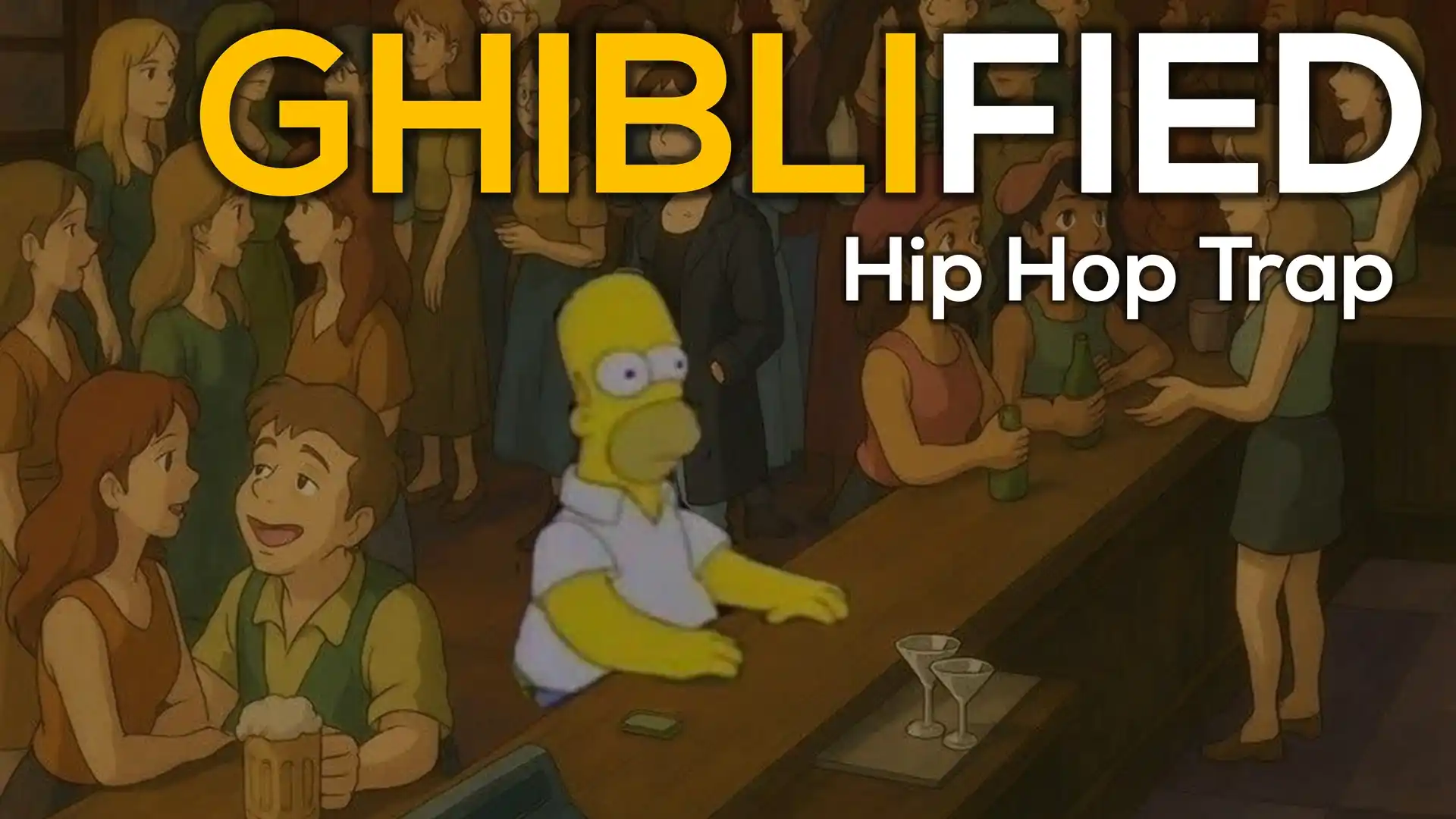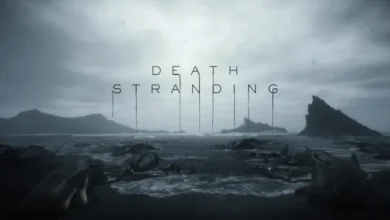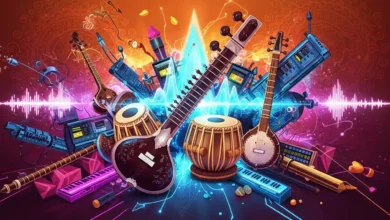Have you ever looked at your breakfast and thought, “This toast needs more magic?” If so, you’ve been Ghiblified. And you’re not alone. The song “Ghiblified” perfectly captures the viral obsession with turning the mundane into a Studio Ghibli masterpiece.
From Selfies to Street Sweepers: Nothing Escapes the Ghibli Glow
The song hilariously describes how social media feeds have been taken over by this trend. It’s not just selfies getting the treatment. Cats, moving day chaos, traffic jams – even grocery hauls are being reimagined with that signature soft pastel aesthetic and those big, shiny, anime eyes.
The Reality Check:
The song also acknowledges the funny contrast between the filtered fantasy and the, well, reality. A messy apartment doesn’t quite fit the Ghibli vibe. But hey, even if real life isn’t always a serene, hand-drawn dream, there’s something undeniably appealing about seeing your sneakers “Ghiblified”.
AI and the Ghibli-verse
The song doesn’t explicitly mention AI, but let’s be real – AI is a huge part of this trend. Countless apps and filters let you instantly transform your photos and videos into Ghibli-esque scenes. It’s like having your own personal Totoro living in your phone.
The Ghiblification Spreads
“Ghiblification spreading far and wide” [00:52], [01:55] isn’t just a lyric; it’s a prophecy. This trend has swept across the internet like a gentle, pastel-colored wildfire. So, embrace the Ghibli glow. Ghiblify your life. Just maybe don’t try to Ghiblify your taxes. Some things are best left in the real world.
Now lets talk a bit more about the viral Studio Ghibli AI trend in detail
The Spark That Lit the Ghibli Fire
Picture this: it’s March 24, 2025, and OpenAI, those tech wizards who love to stir the digital pot, drop their shiny new GPT-4o image generator. Suddenly, anyone with a smartphone and a dream can transform their boring vacation pics into something that looks like it was hand-drawn by Miyazaki himself. Soft pastels, oversized eyes, and dreamy landscapes? Yes, please! The internet, ever the sucker for a shiny new toy, went absolutely feral.
The trend exploded when Seattle-based software engineer Grant Slatton tweeted a “Ghiblified” photo of his family and dog at the beach, captioned with the kind of smug tech-bro energy that screams, “Look at me, I’ve cracked the code to internet fame!” His post racked up 45 million views faster than you can say “Spirited Away.” Suddenly, everyone from influencers to the White House (yes, the White House) was “Ghiblifying” everything—memes, pets, even that one awkward prom photo you swore you’d burned.
OpenAI’s CEO, Sam Altman, couldn’t resist jumping on the bandwagon, swapping his profile pic for a Ghibli-fied version of himself and joking about waking up to “hundreds of messages” about his twink-ish anime glow-up. The man was out here trying to cure cancer with AI, but apparently, the internet only cares when you can make their dog look like it’s about to deliver Kiki’s packages.
Why Ghibli? Because Nostalgia Hits Harder Than a Catbus
So, why did this trend hit like a meteor? Studio Ghibli, for the uninitiated, is the Japanese animation studio that’s been making us cry over forest spirits and flying castles since 1985. Founded by Hayao Miyazaki, the guy who probably dreams in watercolors, Ghibli’s films like Spirited Away, My Neighbor Totoro, and Howl’s Moving Castle are the cinematic equivalent of a warm hug from a magical grandma. Their signature style—lush landscapes, cozy vibes, and characters with eyes bigger than their existential crises—screams universal appeal.
The AI filter nailed this aesthetic with creepy precision, turning your grainy iPhone snaps into scenes that could pass for a Ghibli outtake. It was nostalgia on steroids. Who doesn’t want to look like they’re about to embark on a quest to save a cursed prince or befriend a grumpy dust sprite? Plus, it was stupidly easy. Upload a photo, type “Ghiblify this,” and bam—your Tinder profile pic now looks like it belongs in a Miyazaki masterpiece.
Social media platforms, especially X, became a Ghibli-fied fever dream. Memes got the treatment (the “Distracted Boyfriend” meme as a Ghibli scene? Iconic). Politicians, celebrities, and even Elon Musk balancing spoons at a Trump dinner got the anime makeover. The White House even posted a Ghibli-style image of a crying woman arrested by ICE, which, let’s be real, was a PR disaster so tone-deaf it deserves its own Oscar for “What Were You Thinking?”
The Backlash: Miyazaki’s Ghost Haunts the Algorithm
But oh, the irony. While the internet was busy turning their lives into Ghibli fan art, Hayao Miyazaki, the 84-year-old Ghibli godfather, was probably somewhere in Tokyo, shaking his head so hard his glasses fell off. Miyazaki has been vocal about his hatred for AI, famously calling it “an insult to life itself” in a 2016 documentary after watching a creepy AI-generated zombie animation. The man’s entire career is built on painstaking, hand-drawn frames that take years to craft, so seeing his style reduced to a 10-second AI filter was probably like watching someone deep-fry a Michelin-star meal.
Fans and artists didn’t hold back either. Reddit threads lit up with users calling the trend “disgusting” and accusing AI of “ripping off” Ghibli’s soul. Animation purists argued that mimicking Ghibli’s style wasn’t just lazy—it was borderline theft. “It’s not replicating, it’s stealing,” said animation academic Deborah Szapiro, probably while clutching her Princess Mononoke Blu-ray. Others pointed out the environmental irony: Ghibli films preach living in harmony with nature, while AI data centers guzzle enough energy to power a small country.
Then there was the privacy nightmare. Cybersecurity experts rained on the parade, warning that uploading your photos to these AI tools was like handing your diary to a shady car salesman. Terms of service were vaguer than a politician’s campaign promise, and experts like McAfee’s Pratim Mukherjee cautioned that your cute Ghibli-fied selfie could end up training AI for surveillance or ads. Worse, “model inversion attacks” could potentially reconstruct your original photo, meaning your soft-launch boyfriend reveal might not be so soft after all. Proton Privacy’s X post summed it up: “If it’s free, you (& your data) are the price.”
The Fizzle: From Viral Craze to Digital Dust
By late March, OpenAI’s servers were “melting” under the weight of Ghibli-mania, forcing them to slap rate limits on free users (three images a day, calm down, Karen). But like all internet trends, the Ghibli craze had the shelf life of a carton of milk left out in the sun. By April, X users were already calling it “overused and tiresome” in less than 48 hours. By May 2025, the trend was deader than a No-Face without a buffet.
Why the quick burnout? First, oversaturation. When everyone from your cousin to the White House is posting Ghibli-fied pics, it stops feeling special. Second, OpenAI started cracking down, blocking prompts that explicitly mentioned “Studio Ghibli” due to copyright concerns, forcing users to get creative with workarounds like “soft pastel anime style.” Third, the internet’s attention span is shorter than a goldfish with ADHD. By April, people were probably distracted by a new TikTok dance or a meme coin named after Totoro.
The Legacy: A Cautionary Tale of Viral Whimsy
So, what’s the takeaway from this whirlwind? The Studio Ghibli AI trend was a masterclass in how fast the internet can latch onto something shiny and then drop it like a hot potato. It showed us the power of AI to democratize creativity—anyone could be a Ghibli character for a day—but also the ethical minefield of exploiting artistic styles without permission. It’s like throwing a party in someone’s house while they’re on vacation and then leaving dirty dishes in the sink.
For artists, it was a gut punch, a reminder that AI can churn out “good enough” imitations that threaten their livelihoods. For users, it was a fun but risky game, with privacy concerns lurking like a shadowy forest spirit. And for Miyazaki? Well, he’s probably still muttering about the “end times” while sketching his next masterpiece by hand.
Conclusion: The Internet’s Short-Lived Love Affair
The Studio Ghibli AI trend was a brief, beautiful, problematic blip in the internet’s chaotic timeline. It reminded us that we’re all suckers for nostalgia, but also that viral fads are about as enduring as a sandcastle at high tide. Two months later, it’s a distant memory, overshadowed by whatever new shiny thing the internet’s obsessing over now (probably AI-generated Pokémon filters, let’s be real). So, here’s to the Ghibli craze: a fleeting moment when we all pretended to live in a Miyazaki movie, until we got distracted and wandered off into the digital sunset.
Follow InMusicFlix on Social Media. Click here




